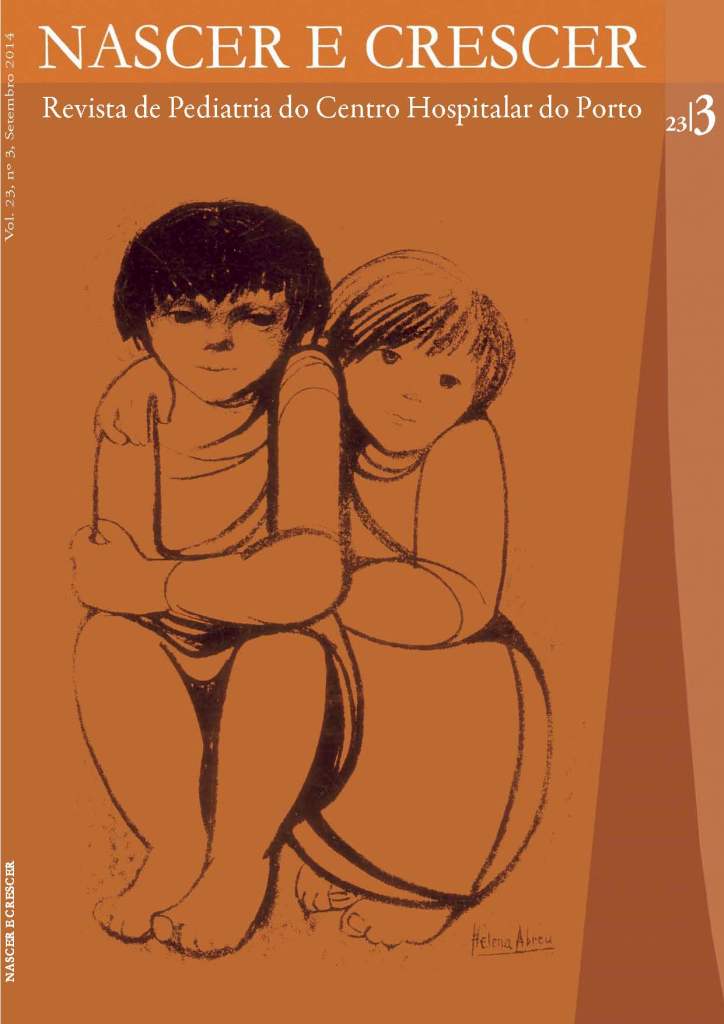Oesophageal atresia: a 10-year experience of a Paediatric Intensive Care Unit
DOI:
https://doi.org/10.25753/BirthGrowthMJ.v23.i3.8693Keywords:
Complications, oesophageal atresia, outcome, surgeryAbstract
Background/Purpose: Oesophageal atresia (OA) is a congenital malformation with a variable prognosis. The aims were to establish OA’s incidence in the central region, to characterize infants with OA admitted and to compare its clinical outcome after surgical repair, according to OA classifi cation.
Methods: A retrospective review of infants with OA admitted to a PICU, after surgical repair, between 2002 and 2011. Patient characteristics, OA’s classifi cation, surgery, morbidity and mortality were analyzed. Two groups were compared according to OA classifi cation.
Results: Thirty-four infants were admitted, out of which 65% were male, with a median gestational age of 36 weeks and birth weight of 2310g. Nineteen of them presented other malformations, mainly cardiac. Nine cases were classifi ed as long-gap OA. Fistula ligation and primary oesophageal anastomosis was the most common surgical option (n=27). Early complications occurred in 13 infants (38%), mostly anastomotic leak, and were similar according to gap length (p=0.704). PICU stay and mechanical ventilation were longer in long-gap OA patients (p=0.009 and p<0.001 respectively) and in infants with other malformations (p=0.027 and p=0.003 respectively). There was no mortality.
Conclusions: The frequency of OA associated malformations implies a systematic screening of these patients. Gap length and presence of associated malformations were the major determinants of length of intensive care stay and ventilation days in OA patients.
Downloads
References
Holland AJA, Fitzgerald DA. Oesophageal atresia and trachea-oesophageal fi stula: current management strategies and complications. Paediatric Respiratory Reviews 2010; 11:100-7.
Kovesi T, Rubin S. Long-term complications of congenital oesophageal atresia and/or tracheo-oesophageal fi stula. Chest 2004; 126:915-25.
Spitz L. Oesophageal atresia. Orphanet J Rare Dis 2007; 2:24.
Jong EM, Felix JF, Klein A, Tibboel D. Etiology of oesophageal atresia and tracheooesophageal fi stula: “mind the gap”. Curr Gastroenterol Rep 2010; 12:215-22.
Solomon BD. VACTERL/VATER association. Orphanet J Rare Dis 2011; 6:56.
Pedersen RN, Calzolari E, Husby S, Garne E; EUROCAT Working group. Oesophageal atresia: prevalence, prenatal diagnosis and associated anomalies in 23 European regions. Arch Dis Child 2012; 97:227-32.
Aslanabadi S, Ghabili K, Rouzrokh M, Hosseini MB, Jamshidi M, Adi FH, et al. Associated congenital anomalies between neonates with short-gap and long-gap oesophageal atresia: a comparative study. Int J Gen Med 2011; 4:487-91.
Hunter CJ, Petrosyan M, Connelly ME, Ford Hr, Nguyen NX. Repair of long-gap oesophageal atresia: gastric conduits may improve outcome – a 20-year single center experience. Pediatr Surg Int 2009; 25:1087-91.
Driver CP, Shankar KR, Jones MO, Lamont GA, Turnock RR, Lloyd DA, et al. Phenotypic presentation and outcome of oesophageal atresia in the era of the Spitz classifi cation. J Pediatr Surg 2001; 36:1419-21.
Goldstein B, Giroir B, Randolph A. International pediatric sepsis consensus conference: defi nitions for sepsis and organ dysfunction in pediatrics. Pediatr Crit Care Med 2005; 6:2-8.
Krogh C, Gørtz S, Wohlfahrt J, Biggar RJ, Melbye M, Fischer TK. Pre and perinatal risk factors for pyloric stenosis and their influence on the male predominance. Am J Epidemiol 2012; 176:24-31.
Burge DM, Shah K, Spark P, Shenker N, Pierce M, Kurinczuk JJ, et al. Contemporary management and outcomes for infants born with oesophageal atresia. Br J Surg 2013; 100:515-21.
Koivusalo AI, Pakarinen MP, Rintala RJ. Modern outcomes of oesophageal atresia: Single centre experience over the last twenty years. J Pediatr Surg 2013; 48:297-303.
Lopes MF, Botelho MF. Midterm follow-up of esophageal anastomosis for esophageal atresia repair: long-gap versus non long-gap. Dis Esophagus 2007; 20:428-35.
Lopes MF, Reis A, Coutinho S, Pires A. Very long gap esophageal atresia successfully treated by esophageal engthening using external traction sutures. J Pediatr Surg 2004; 39:1286-7.
Mansur SH, Talat N, Ahmed S. Oesophageal atresia: role of gap length in determining the outcome. Biomedica 2005;
:125-8.
Downloads
Published
How to Cite
Issue
Section
License
Copyright and Authors' Rights
All articles published in Nascer e Crescer - Birth and Growth Medical Journal are Open Access and comply with the requirements of funding agencies or academic institutions. For use by third parties, Nascer e Crescer - Birth and Growth Medical Journal adheres to the terms of the Creative Commons License "Attribution - Non-Commercial Use (CC-BY-NC)".
It is the author's responsibility to obtain permission to reproduce figures, tables, etc. from other publications.
Authors must submit a Conflict of Interest statement and an Authorship Form with the submission of the article. An e-mail will be sent to the corresponding author confirming receipt of the manuscript.
Authors are permitted to make their articles available in repositories at their home institutions, provided that they always indicate where the articles were published and adhere to the terms of the Creative Commons license.


